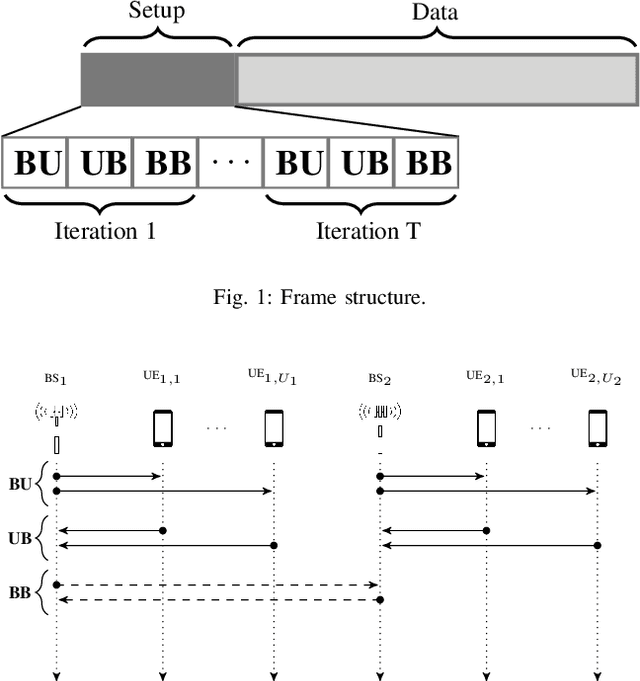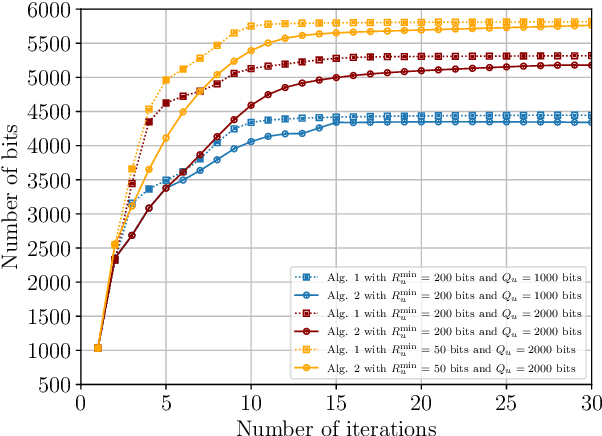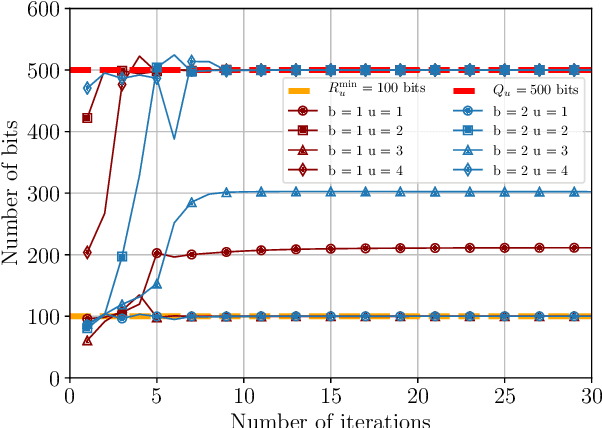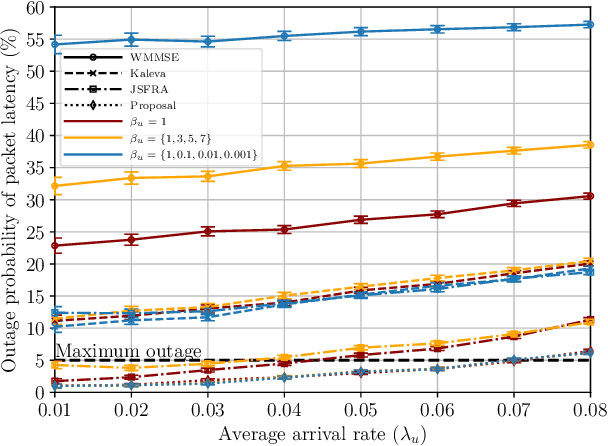Roberto P. Antonioli
Efficient Battery Usage in Wireless-Powered Cell-Free Systems with Self-Energy Recycling
Dec 28, 2022Abstract:This paper investigates wireless-powered cell-free systems, in which the users send their uplink data signal while simultaneously harvesting energy from network nodes and user terminals - including the transmitting user terminal itself - by performing self-energy recycling. In this rather general setting, a closed-form lower bound of the amount of harvested energy and the achieved signal-to-interference-plus-noise ratio expressions are derived. Then, to improve the energy efficiency, we formulate the problem of minimizing the users' battery energy usage while satisfying minimum data rate requirements. Due to the non-convexity of the problem, a novel alternating optimization algorithm is proposed, and its proof of convergence is provided. Finally, numerical results show that the proposed method is more efficient than a state-of-art algorithm in terms of battery energy usage and outage rate.
A Distributed Game-Theoretic Solution for Power Management in the Uplink of Cell-Free Systems
Dec 28, 2022Abstract:This paper investigates cell-free massive multiple input multiple output systems with a particular focus on uplink power allocation. In these systems, uplink power control is highly non-trivial, since a single user terminal is associated with multiple intended receiving base stations. In addition, in cell-free systems, distributed power control schemes that address the inherent spectral and energy efficiency targets are desirable. By utilizing tools from game theory, we formulate our proposal as a noncooperative game, and using the best-response dynamics, we obtain a distributed power control mechanism. To ensure that this power control game converges to a Nash equilibrium, we apply the theory of potential games. Differently from existing gamebased schemes, interestingly, our proposed potential function has a scalar parameter that controls the power usage of the users. Numerical results confirm that the proposed approach improves the use of the energy stored in the battery of user terminals and balances between spectral and energy efficiency.
Mixed Coherent and Non-Coherent Transmission for Multi-CPU Cell-Free Systems
Dec 28, 2022



Abstract:Existing works on cell-free systems consider either coherent or non-coherent downlink data transmission and a network deployment with a single central processing unit (CPU). While it is known that coherent transmission outperforms noncoherent transmission when assuming unlimited fronthaul links, the former requires a perfect timing synchronization, which is practically not viable over a large network. Furthermore, relying on a single CPU for geographically large cell-free networks is not scalable. Thus, to realize the expected gains of cellfree systems in practice, alternative transmission strategies for realistic multi-CPU cell-free systems are required. Therefore, this paper proposes a novel downlink data transmission scheme that combines and generalizes the existing coherent and non-coherent transmissions. The proposed transmission scheme, named mixed transmission, works based on the realistic assumption that only the access points (APs) controlled by a same CPU are synchronized, and thus transmit in a coherent fashion, while APs from different CPUs require no synchronism and transmit in a non-coherent manner. We also propose extensions of existing clustering algorithms for multi-CPU cell-free systems with mixed transmission. Simulation results show that the combination of the proposed clustering algorithms with mixed transmission have the potential to perform close to the ideal coherent transmission.
Joint Resource Allocation and Transceiver Design for Sum-Rate Maximization under Latency Constraints in Multicell MU-MIMO Systems
Mar 29, 2021



Abstract:Due to the continuous advancements of orthogonal frequency division multiplexing (OFDM) and multiple antenna techniques, multiuser multiple input multiple output (MU-MIMO) OFDM is a key enabler of both fourth and fifth generation networks. In this paper, we consider the problem of weighted sum-rate maximization under latency constraints in finite buffer multicell MU-MIMO OFDM systems. Unlike previous works, the optimization variables include the transceiver beamforming vectors, the scheduled packet size and the resources in the frequency and power domains. This problem is motivated by the observation that multicell MU-MIMO OFDM systems serve multiple quality of service classes and the system performance depends critically on both the transceiver design and the scheduling algorithm. Since this problem is non-convex, we resort to the max-plus queuing method and successive convex approximation. We propose both centralized and decentralized solutions, in which practical design aspects, such as signaling overhead, are considered. Finally, we compare the proposed framework with state-of-the-art algorithms in relevant scenarios, assuming a realistic channel model with space, frequency and time correlations. Numerical results indicate that our design provides significant gains over designs based on the wide-spread saturated buffers assumption, while also outperforming algorithms that consider a finite-buffer model.
Decentralized Joint Beamforming, User Scheduling and QoS Management in 5G and Beyond Systems
Feb 23, 2021



Abstract:Fifth generation cellular systems support a broad range of services, including mobile broadband, critical and massive Internet of Things and are used in a variety of scenarios. In many of these scenarios, the main challenge is maintaining high throughput and ensuring proper quality of service (QoS) in irregular topologies. In multiple input multiple output systems, this challenge translates to designing linear transmit and receive beamformers that maximize the system throughput and manage QoS constraints. In this paper, we argue that this basic design task in 5G and beyond systems must be extended such that beamforming design and user scheduling are managed jointly. Specifically, we propose a fully decentralized joint beamforming design and user scheduling algorithm that manages QoS. A novel feature of this scheme is its ability to reduce the initial rate requirements in case of infeasibility. By means of simulations that model contemporary 5G scenarios, we show that the proposed decentralized scheme outperforms benchmarking algorithms that do not support minimum rate requirements and previously proposed algorithms that support QoS requirements.
 Add to Chrome
Add to Chrome Add to Firefox
Add to Firefox Add to Edge
Add to Edge